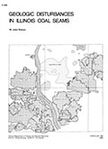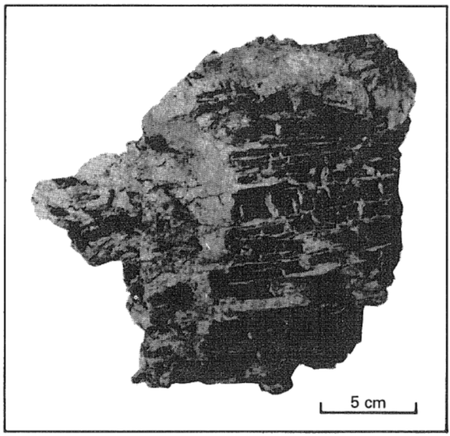Circular 530 White Top
| Geologic Disturbances in Illinois Coal Seams | ||||||||||
|---|---|---|---|---|---|---|---|---|---|---|
| Channels | Split Coal | Rolls | Limestone Bosses | Clay Dikes | White Top | Igneous Dikes | Joints | Coal Balls | Miscellaneous Disturbances | Acknowledgments |
White Top
White top is a mining term for coal intensively broken and mixed with light-colored clay or sand. It is found at or near the top of the seam, closely associated with clay dikes, limestone bosses, and similar disturbances. Most descriptions of white top are from the Herrin Coal around the western and northern margins of the Illinois Basin. The term white top is also used by some miners for soft, light gray shales in predominantly black roof. Such usage is confusing, yet there is no scientific term for true white top. The origin of white top is still a puzzle. A close look at a specimen (fig. 33) shows coal and clay are not just jumbled together; coal is still horizontally layered, and clay has been injected into cracks and between layers. This fact rules against early theories that white top is a stream deposit. The close association of clay dikes with white top suggests that both formed by the same process.
Mining problems.
In most parts of Illinois, this deposit is extremely thin and localized, found mainly around clay dikes. Although it may weaken the roof or add some clay to the coal, it has little effect on mining. In northwestern Illinois, however, the white top can be thick and extensive. Damberger (1970, 1973) has described areas of white top up to several hundred feet across in strip mines of Fulton and Peoria Counties. In some places, the upper half or more of the seam is so mixed with clay and silt that it is not worth mining. Removing pockets of white top leaves depressions on top of the coal; these holes fill with water and mud, making it difficult to haul coal out of the pit.
In Bureau and La Salle Counties, white top in the roof of underground mines in the Herrin Coal was too weak to leave in the roof and too dirty to ship with the coal (Cady, 1915). Because it was rich in both coal and pyrite, gobbing it underground often led to spontaneous fires.
References
- Cady, G. H., 1915, Coal resources of District I (longwall): Illinois Geological Survey Cooperative Coal Mining Investigations Bulletin 10, 149 p.
- Damberger, H. H., 1970, Clastic dikes and related impurities in Herrin (No. 6) and Springfield (No. 5) Coals of the Illinois Basin, in Depositional Environments in Parts of the Carbondale Formation-Western and Northern Illinois: Illinois State Geological Survey Guidebook 8, p. 1 1 1 - 1 19.
- Damberger, H. H., 1973, Physical properties of the Illinois Herrin (No. 6) Coal before burial, as inferred from earthquake induced disturbances: Compte Rendu, Seventh International Congress of Carboniferous Stratigraphy and Geology, v. 2, p. 341 -350.


